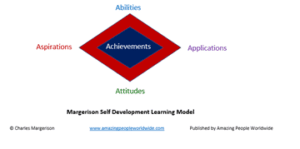Bioview Life Scripts
By Dr Charles Margerison
Psychologist
Life Script Writing To Support Character & Wellbeing
Teachers are expected to provide guidance to students on character development and wellbeing issues. However, most teachers have not been provided with specific training on such issues. This article provides a practical approach that can be used in lessons on science, music, social studies, history, literature, plus applications in technology and business education classes.
It involves what I have named the Bioview Method. The term bioview is derived from biographical interview. In effect, a bioview is a written interview that a student creates after researching the life of an amazing person that they regard as inspiring.
In the process, the student identifies the character factors that enabled people like William Shakespeare, Harriet Tubman, Thomas Edison and Dr Marie Curie to succeed despite the difficulties they faced. They can also note the issues that influenced the wellbeing of the people and see how those issues can be used in their own lives.
The Bioview Method has been used in a range of American, UK and Australian schools with students ranging in age from 8 to 18. It has been used in classrooms that focus on different curriculum topics including science, social studies, and history. It has also been used to facilitate discussion on cultural factors in different societies and the impact on character and wellbeing.
Applications & Process – Guide For Writing Your Script
Students are asked to choose an inspirational person from history to study. The steps in creating a bioview are as follows:
- The student sets out a number of questions that they wish to explore about the life of the amazing person chosen. This can be based on what is often called the Achievements Model (shown below). The key words provide the start point for a research question. An example could be the word Aspirations. The student therefore can research what aspirations the chosen person had in their work.
- The student can research in various ways to gather information about the work of their chosen person and their life and times.
- The student can discuss their questions and findings with other students to provide mutual support.
- The student can then write a bioview on the named person. This is done in the first person singular. Each line should be short and make a point of opinion, a fact or a description.
At the end of the process, each student should write a document that covers the following questions: - At the end of the process, each student should write a document that covers the following questions:
- What did I learn about character development and wellbeing from this project?
- In particular, what did I learn about my own character and wellbeing from doing the project?
This is the very important reflective aspect that enables a student to focus on their character development and wellbeing, rather than just completing the project task and gaining a mark from the teacher.
Understanding Of Achievements
Students can understand how amazing people developed their contributions by following the achievements model. By reading the bioview of an amazing person the student can perceive what the inspirational person did. They can then write a reflective review indicating how they could apply the main issues arising to their own lives. They can do this in the following ways based on the four key words in the achievements model:
- Abilities – What abilities did the amazing person in the bioview exhibit? Which of these do you intend to focus upon to improve your own achievements?
- Aspirations – We all have ideas and dreams that we convert to aspirations and ambitions. What do you regard as the main aspirations of the person whose life story you have read? What are your own aspirations and ambitions?
- Attitudes – What were the main attitudes that you detected in the life story of the amazing person? Which of these will you focus upon in order to improve your achievements?
- Applications – What were the major applications that the amazing person used in order to succeed? What applications do you need to make in your own life in terms of how you use your time and energy in order to succeed?
The Psychology Of Self-Understanding
The most important part of learning is understanding how to use one’s time in a way that engenders happiness and a style of life that sustains wellness. The Margerison Bioview Method is an important part of that. It enables students to understand how people who made major achievements in life used their time and talents.
In the process, they all had to face personal challenges such as illness, accidents, loss of friends and family and deal with the everyday issues of earning a living. The Bioview Method provides students with the opportunity to see how amazing people met those challenges and learn from them.
Learning Principles To Raise Aspirations
All students need to understand how they can make a success of their lives. By creating biographical interviews (bioviews) of amazing people, who converted ideas into achievements, students can raise their levels of aspiration and ambition.
In the process, they will gain the ability to write their own life scripts by choosing important issues and priorities. By researching the contributions and achievements of inspirational people, in the context of their culture and time, students can also become inspired to make important contributions and achievements in their lives.
1 – Character and Wellbeing Learning Principle – This proposes that a student will learn more about their own character development and wellbeing issues if they have an interest in, and study, the life of inspiring people via the Bioview Method.
2 – Motivation and Engagement Principle – This proposes that a student’s curiosity and commitment to learning about character, wellbeing and achievement capabilities will increase by discussing with others and developing important questions for a virtual bioview investigation.
 3 – Life Research Abilities Principle – This proposes that a student’s abilities to research both objective and subjective issues associated with the philosophy, psychology and sociology of the lives of inspirational people will improve as they research and write bioviews.
3 – Life Research Abilities Principle – This proposes that a student’s abilities to research both objective and subjective issues associated with the philosophy, psychology and sociology of the lives of inspirational people will improve as they research and write bioviews.
4 – Understanding Self and Others Principle – This proposes that a student’s ability to empathise with others and also understand their own character and wellbeing issues will improve by researching and writing the bioviews of people they regard as inspirational.
5 – Personal Development Principle – This proposes that a student’s character and wellbeing plan to guide their behaviour and life choices will improve by discussing and writing a response to the following question – “What did I learn that I can use in my own life from the bioview project?”
Self-Understanding
The psychology of self-understanding is an ongoing process. A foundation is to perceive what others did and the character concepts they focused upon. By looking at the psychology of self and others, students can learn how it is possible to develop confidence and determination to pursue one’s dreams. That is what amazing people did. Helen Keller, Hans Wilsdorf, Rosa Parks, Nelson Mandela and Caroline Chisholm are inspirational exemplars of those who developed their character and used their time well.
Considerable research is now being done on character and wellbeing issues amongst students and adults. Seligman [1] and his colleagues have written a number of books and articles that reflect on the importance of optimism, persistence, resilience for example as character factors that influence wellbeing. In all, 24 major factors have been outlined.
The Jubilee Centre [2], linked to Birmingham University in the U.K., focus on the four key areas of Intellectual, Moral, Civic and Performance virtues as fundamental to character development.
The application of all these values and virtues in the classroom takes time and competes with the pressure on teachers to prepare students for examinations. While schools increasingly focus on character and wellbeing they can learn a lot from organizations such as the Scouts and Girl Guides who have developed well tested approaches.
Character and wellbeing education has many dimensions, inclusive of the psychology processes of self-understanding and how that links to the philosophy of ethics and the study of cultural beliefs and behaviour. As a start point it would help if the psychology of self-development was integral to the school curriculum as a foundation subject at all stages of a student’s school life.
Educators As Facilitators
The role of the teacher is that of a facilitator, or consultant adviser, to help students explore their character and wellbeing issues and how they can be implemented. This can be done in the subject area within which a teacher is a specialist.
So, for example, a science teacher can introduce a bioview on the life of Dr Marie Curie or Dr Louis Pasteur. A music teacher can ask the students to research the life of Mozart or Ella Fitzgerald. History and Social Studies teachers can introduce the bioviews on the lives of Florence Nightingale or Dr Barnardo. Business studies teachers can refer to the bioviews on the lives of Coco Chanel or William Lever. Geography teachers can provide bioviews on explorers like Captain Cook or Amy Johnson.
There are many inspiring life stories that provide students with exemplars for character development and wellbeing. Therefore, the approach is applicable to all curriculum subject areas.
Life Writing – An Integrated Approach
Character education and wellbeing can be encouraged by providing students the opportunity to learn with and from others who used their time well to make important achievements.
The bioview process can be used on a whole school basis in assemblies and then linked to specific applications in class projects. The approach has been used in a wide range of schools for students between the ages of 8 and 18. In each case, the approach supports the curriculum topics as an integrated approach that also helps students learn about their own character and wellbeing.
References
Peterson, Christopher; Seligman, Martin E.P. (2004) Character Strengths and Virtues: A Handbook and Classification. Oxford: Oxford University Press. ISBN 0-19-516701-5
Jubilee Centre for Character and Virtues (2015) Statement on Teacher Education and Character Education. Birmingham: University of Birmingham. Online at: http://www.jubileecentre.ac.uk/userfiles/jubileecentre/pdf/character-education/Statement_on_Teacher_Education_and_Character_Education.pdf
Arthur, J., Kristjánsson, K., Harrison, T., Sanderse, W., and Wright, D. (2017) Teaching Character and Virtue in Schools. London: Routledge
Margerison C. J. (2017) Character, Citizenship and Culture. Research Paper for Amazing People Worldwide – www.amazingpeopleworldwide.com
Goleman, D. (2013) Focus. Bloomsbury Publishing, London. ISBN 978 1 4088 2911 0
Seligman, M. (2011) Flourish. W Heineman, Australia. ISBN 978 1 86471 298 8










